wheel Abarth Grande Punto 2009 Owner handbook (in English)
[x] Cancel search | Manufacturer: ABARTH, Model Year: 2009, Model line: Grande Punto, Model: Abarth Grande Punto 2009Pages: 207, PDF Size: 3.01 MB
Page 90 of 207
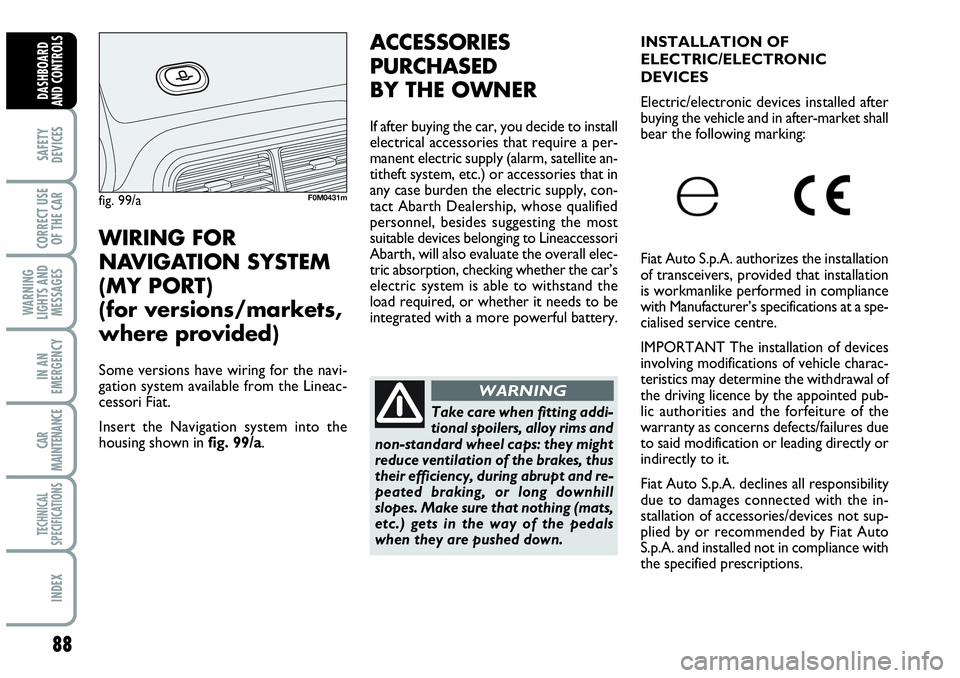
ACCESSORIES
PURCHASED
BY THE OWNER
If after buying the car, you decide to install
electrical accessories that require a per-
manent electric supply (alarm, satellite an-
titheft system, etc.) or accessories that in
any case burden the electric supply, con-
tact Abarth Dealership, whose qualified
personnel, besides suggesting the most
suitable devices belonging to Lineaccessori
Abarth, will also evaluate the overall elec-
tric absorption, checking whether the car’s
electric system is able to withstand the
load required, or whether it needs to be
integrated with a more powerful battery.
Take care when fitting addi-
tional spoilers, alloy rims and
non-standard wheel caps: they might
reduce ventilation of the brakes, thus
their efficiency, during abrupt and re-
peated braking, or long downhill
slopes. Make sure that nothing (mats,
etc.) gets in the way of the pedals
when they are pushed down.
WARNING
INSTALLATION OF
ELECTRIC/ELECTRONIC
DEVICES
Electric/electronic devices installed after
buying the vehicle and in after-market shall
bear the following marking:
Fiat Auto S.p.A. authorizes the installation
of transceivers, provided that installation
is workmanlike performed in compliance
with Manufacturer’s specifications at a spe-
cialised service centre.
IMPORTANT The installation of devices
involving modifications of vehicle charac-
teristics may determine the withdrawal of
the driving licence by the appointed pub-
lic authorities and the forfeiture of the
warranty as concerns defects/failures due
to said modification or leading directly or
indirectly to it.
Fiat Auto S.p.A. declines all responsibility
due to damages connected with the in-
stallation of accessories/devices not sup-
plied by or recommended by Fiat Auto
S.p.A. and installed not in compliance with
the specified prescriptions.
88
SAFETY
DEVICES
CORRECT USE
OF THE CAR
WARNING
LIGHTS AND
MESSAGES
IN AN
EMERGENCY
CAR
MAINTENANCE
TECHNICAL
SPECIFICATIONS
INDEX
DASHBOARD
AND CONTROLS
fig. 99/aF0M0431m
WIRING FOR
NAVIGATION SYSTEM
(MY PORT)
(for versions/markets,
where provided)
Some versions have wiring for the navi-
gation system available from the Lineac-
cessori Fiat.
Insert the Navigation system into the
housing shown in fig. 99/a.
Page 105 of 207
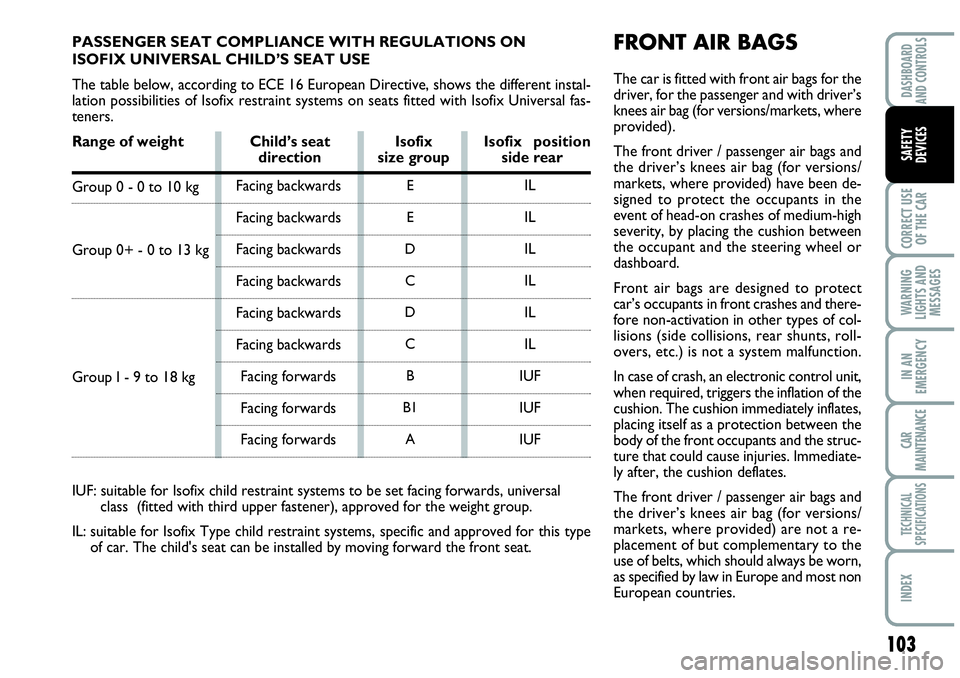
103
CORRECT USE
OF THE CAR
WARNING
LIGHTS AND
MESSAGES
IN AN
EMERGENCY
CAR
MAINTENANCE
TECHNICAL
SPECIFICATIONS
INDEX
DASHBOARD
AND CONTROLS
SAFETY
DEVICES
FRONT AIR BAGS
The car is fitted with front air bags for the
driver, for the passenger and with driver’s
knees air bag (for versions/markets, where
provided).
The front driver / passenger air bags and
the driver’s knees air bag (for versions/
markets, where provided) have been de-
signed to protect the occupants in the
event of head-on crashes of medium-high
severity, by placing the cushion between
the occupant and the steering wheel or
dashboard.
Front air bags are designed to protect
car’s occupants in front crashes and there-
fore non-activation in other types of col-
lisions (side collisions, rear shunts, roll-
overs, etc.) is not a system malfunction.
In case of crash, an electronic control unit,
when required, triggers the inflation of the
cushion. The cushion immediately inflates,
placing itself as a protection between the
body of the front occupants and the struc-
ture that could cause injuries. Immediate-
ly after, the cushion deflates.
The front driver / passenger air bags and
the driver’s knees air bag (for versions/
markets, where provided) are not a re-
placement of but complementary to the
use of belts, which should always be worn,
as specified by law in Europe and most non
European countries. Facing backwards
Facing backwards
Facing backwards
Facing backwards
Facing backwards
Facing backwards
Facing forwards
Facing forwards
Facing forwards
IL
IL
IL
IL
IL
IL
IUF
IUF
IUFE
E
D
C
D
C
B
B1
A
PASSENGER SEAT COMPLIANCE WITH REGULATIONS ON
ISOFIX UNIVERSAL CHILD’S SEAT USE
The table below, according to ECE 16 European Directive, shows the different instal-
lation possibilities of Isofix restraint systems on seats fitted with Isofix Universal fas-
teners.
Range of weight Child’s seat Isofix Isofix position
direction size group side rear
Group 0 - 0 to 10 kg
Group 0+ - 0 to 13 kg
Group I - 9 to 18 kg
IUF: suitable for Isofix child restraint systems to be set facing forwards, universal
class (fitted with third upper fastener), approved for the weight group.
IL: suitable for Isofix Type child restraint systems, specific and approved for this type
of car. The child's seat can be installed by moving forward the front seat.
Page 106 of 207

104
CORRECT USE
OF THE CAR
WARNING
LIGHTS AND
MESSAGES
IN AN
EMERGENCY
CAR
MAINTENANCE
TECHNICAL
SPECIFICATIONS
IINDEX
DASHBOARD
AND CONTROLS
SAFETY
DEVICES
PASSENGER’S FRONT AIR BAG
fig. 15
It consists of an instant-inflating cushion
contained into a special recess in the dash-
board, this cushion has a volume bigger
than that of the driver. In minor crashes (for which the restrain-
ing action of the seat belts is sufficient), the
air bags are not deployed. Also in this case
it is of vital importance to wear the seat
belts since in case of side crash they guar-
antee proper positioning of the occupant
and prevent the occupants to be pitched
out of the car in case of violent crashes.
DRIVER’S FRONT AIR BAG fig. 14
It consists of an instant-inflating cushion
contained in a special recess in the cen-
tre of the steering wheel.
Do not apply stickers or oth-
er objects to the steering
wheel or to the air bag cover on the
passenger’s side or on the side roof
lining. Never put objects (e.g. mobile
phones) on the dashboard on pas-
senger side since they could interfere
with proper air bag inflation and al-
so cause serious injury.
WARNINGThe volume of front air bags at max. in-
flation fills most of the space between the
steering wheel and the driver and between
the dashboard and the passenger.
In case of crash, a person not wearing the
seat belt moves forward and may come in-
to contact with the cushion while it is still
inflating. Under this circumstance the pro-
tection offered by the air bag is reduced.
Front air bag may not be activated in the
following situations:
❒in collisions against highly deformable
objects not affecting the car front sur-
face (e.g. bumper collision against guard
rail, etc.);
❒ in case of wedging under other vehicles
or protective barriers (for example un-
der a truck or guard rail), the air bag
is not triggered as it offers no additional
protection compared with the seat
belts, consequently it would be point-
less. Therefore, failure to come into ac-
tion in the above circumstance does
not mean that the system is not work-
ing properly.
fig. 14F0M031Ab
fig. 15F0M032Ab
Page 110 of 207
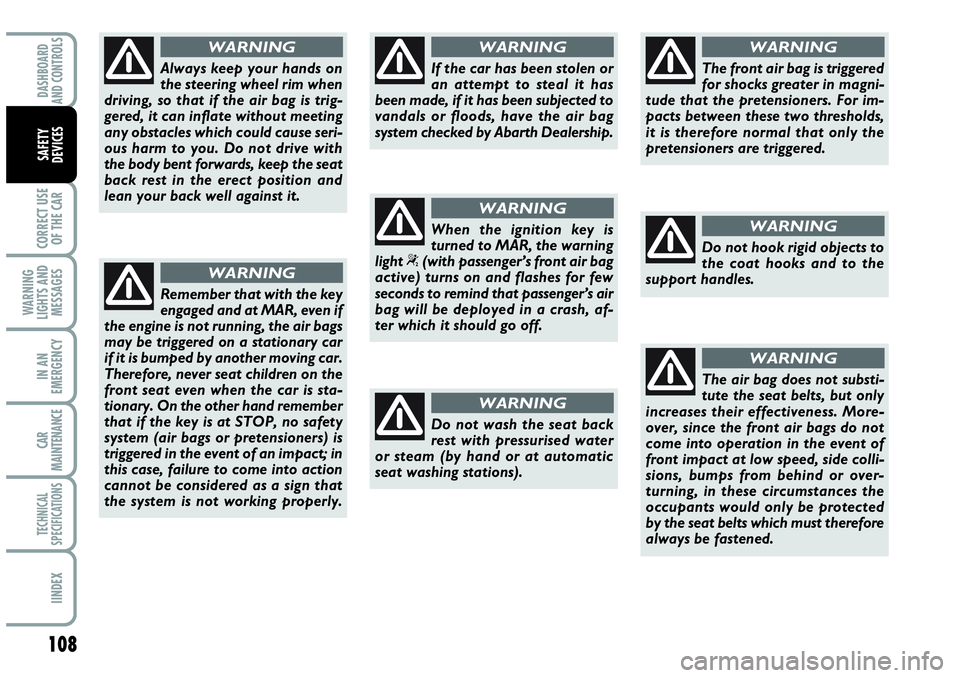
108
CORRECT USE
OF THE CAR
WARNING
LIGHTS AND
MESSAGES
IN AN
EMERGENCY
CAR
MAINTENANCE
TECHNICAL
SPECIFICATIONS
IINDEX
DASHBOARD
AND CONTROLS
SAFETY
DEVICES
Always keep your hands on
the steering wheel rim when
driving, so that if the air bag is trig-
gered, it can inflate without meeting
any obstacles which could cause seri-
ous harm to you. Do not drive with
the body bent forwards, keep the seat
back rest in the erect position and
lean your back well against it.
WARNING
Remember that with the key
engaged and at MAR, even if
the engine is not running, the air bags
may be triggered on a stationary car
if it is bumped by another moving car.
Therefore, never seat children on the
front seat even when the car is sta-
tionary. On the other hand remember
that if the key is at STOP, no safety
system (air bags or pretensioners) is
triggered in the event of an impact; in
this case, failure to come into action
cannot be considered as a sign that
the system is not working properly.
WARNING
Do not wash the seat back
rest with pressurised water
or steam (by hand or at automatic
seat washing stations).
WARNING
The front air bag is triggered
for shocks greater in magni-
tude that the pretensioners. For im-
pacts between these two thresholds,
it is therefore normal that only the
pretensioners are triggered.
WARNING
Do not hook rigid objects to
the coat hooks and to the
support handles.
WARNING
The air bag does not substi-
tute the seat belts, but only
increases their effectiveness. More-
over, since the front air bags do not
come into operation in the event of
front impact at low speed, side colli-
sions, bumps from behind or over-
turning, in these circumstances the
occupants would only be protected
by the seat belts which must therefore
always be fastened.
WARNING
When the ignition key is
turned to MAR, the warning
light “(with passenger’s front air bag
active) turns on and flashes for few
seconds to remind that passenger’s air
bag will be deployed in a crash, af-
ter which it should go off.
WARNING
If the car has been stolen or
an attempt to steal it has
been made, if it has been subjected to
vandals or floods, have the air bag
system checked by Abarth Dealership.
WARNING
Page 112 of 207

110
WARNING
LIGHTS AND
MESSAGES
IN AN
EMERGENCY
CAR
MAINTENANCE
TECHNICAL
SPECIFICATIONS
INDEX
DASHBOARD
AND CONTROLS
SAFETY
DEVICES
CORRECT USE
OF THE CAR
ENGINE STARTING
The car is fitted with an electronic engine
lock device: if the engine fails to start, see
the paragraph “The Fiat CODE system” in
section “Dashboard and controls”.
The engine may be noisier than usual dur-
ing the first seconds of operation, espe-
cially after it has not been used for a while.
This characteristic feature does not com-
promise functionality or reliability of the
hydraulic tappets: the timing system de-
vised to limit servicing.
We recommend that during
the initial period you do not
drive to full car performance
(e.g.: excessive acceleration,
long journeys at top speed, sharp brak-
ing, etc.).
When the engine is switched
off never leave the key into
the ignition switch to prevent
pointless current absorption
from draining the battery.
Running the engine in con-
fined areas is extremely dan-
gerous. The engine consumes oxygen
and produces carbon monoxide
which is a highly toxic and lethal gas.
WARNING
Remember that the servo-
brake and power steering
are not operational until the engine
has been started, therefore much ef-
fort than usual is required on the
brake pedal and steering wheel.
WARNING
Proceed as follows:
❒ensure that the handbrake is up;
❒put the gear lever into neutral;
❒ press the clutch pedal down to the
floor without touching the accelerator;
❒turn the ignition key to AVVand let
it go the moment the engine starts.
If the engine does not start at the first at-
tempt, return the ignition key to STOP
before repeating starting.
If, when the ignition key is at MAR, warn-
ing light
Yremains lit together with
warning light Uturn the key to STOP
STOP and then back to MAR; if the warn-
ing light remains on, try with the other
keys provided with the car.
IMPORTANT If the instrument panel
warning light Ystays on glowing steadi-
ly, contact immediately Abarth Dealership.
IMPORTANT Never leave the ignition key
to MARwhen the engine is off.
Page 113 of 207

111
WARNING
LIGHTS AND
MESSAGES
IN AN
EMERGENCY
CAR
MAINTENANCE
TECHNICAL
SPECIFICATIONS
INDEX
DASHBOARD
AND CONTROLS
SAFETY
DEVICES
CORRECT USE
OF THE CAR
STOPPING THE ENGINE
Turn the ignition to STOPwhile the en-
gine is idling.
IMPORTANT After a taxing drive, you
should allow the engine to “catch its
breath” before turning it off by letting it
idle to allow the temperature in the en-
gine compartment to fall.
A quick burst on the acceler-
ator before turning off the en-
gine serves absolutely no
practical purpose, it wastes
fuel and is damaging especially to tur-
bocharged engines.HOW TO WARM UP THE
ENGINE AFTER IT HAS JUST
STARTED
Proceed as follows:
❒ Drive off slowly, letting the engine turn
at medium revs. Do not accelerate
abruptly;
❒Do not drive at full performance for the
initial kilometres. Wait until the coolant
temperature gauge starts moving.
Remember that the servo-
brake and power steering are
not operational until the en-
gine has been started, there-
fore much effort than usual is required
on the brake pedal and steering wheel.
Never bump start the engine
by pushing, towing or coast-
ing downhill as this could
cause fuel to flow into the
catalytic exhaust system and damage
it beyond repair.
Page 114 of 207
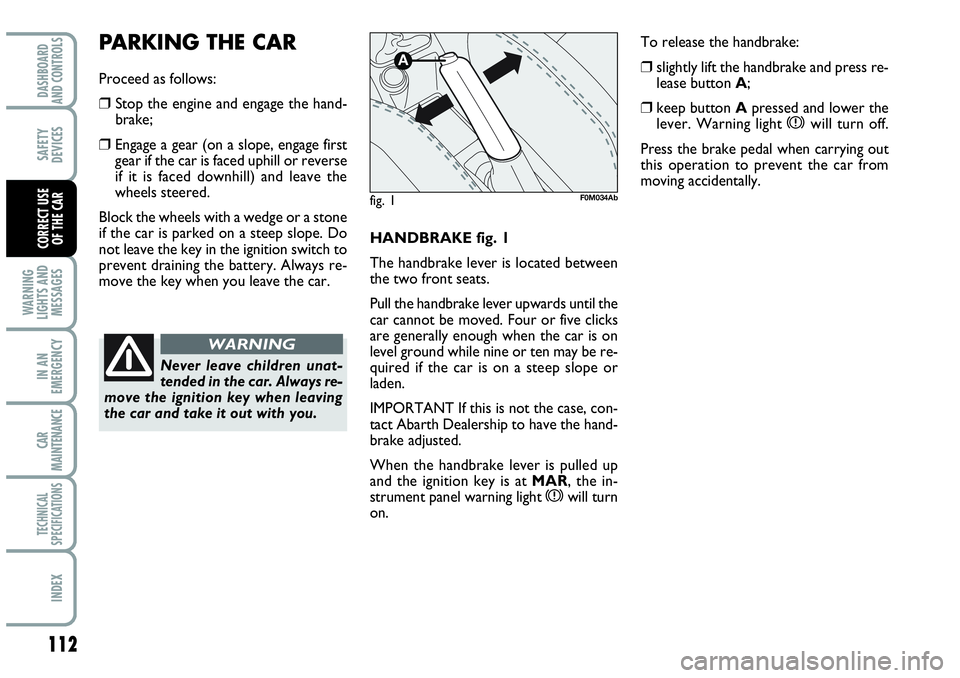
112
WARNING
LIGHTS AND
MESSAGES
IN AN
EMERGENCY
CAR
MAINTENANCE
TECHNICAL
SPECIFICATIONS
INDEX
DASHBOARD
AND CONTROLS
SAFETY
DEVICES
CORRECT USE
OF THE CARHANDBRAKE fig. 1
The handbrake lever is located between
the two front seats.
Pull the handbrake lever upwards until the
car cannot be moved. Four or five clicks
are generally enough when the car is on
level ground while nine or ten may be re-
quired if the car is on a steep slope or
laden.
IMPORTANT If this is not the case, con-
tact Abarth Dealership to have the hand-
brake adjusted.
When the handbrake lever is pulled up
and the ignition key is at MAR, the in-
strument panel warning light
xwill turn
on.
PARKING THE CAR
Proceed as follows:
❒ Stop the engine and engage the hand-
brake;
❒Engage a gear (on a slope, engage first
gear if the car is faced uphill or reverse
if it is faced downhill) and leave the
wheels steered.
Block the wheels with a wedge or a stone
if the car is parked on a steep slope. Do
not leave the key in the ignition switch to
prevent draining the battery. Always re-
move the key when you leave the car.
Never leave children unat-
tended in the car. Always re-
move the ignition key when leaving
the car and take it out with you.
WARNING
To release the handbrake:
❒slightly lift the handbrake and press re-
lease button A;
❒keep button Apressed and lower the
lever. Warning light xwill turn off.
Press the brake pedal when carrying out
this operation to prevent the car from
moving accidentally.
fig. 1
A
F0M034Ab
Page 121 of 207

119
WARNING
LIGHTS AND
MESSAGES
IN AN
EMERGENCY
CAR
MAINTENANCE
TECHNICAL
SPECIFICATIONS
INDEX
DASHBOARD
AND CONTROLS
SAFETY
DEVICES
CORRECT USE
OF THE CAR
SNOW CHAINS
Use of snow chains should be in compli-
ance with local regulations.
Snow chains should only be applied to the
driving wheels (front wheels). We rec-
ommend using Lineaccessori Abarth snow
chains.
Check the tension of the chains after the
first few metres have been driven.
IMPORTANT With snow chains, use the
accelerator with extreme care to prevent
or to limit as much as possible slipping of
the driving wheels that could cause chain
breaking resulting in damages to the car
body or mechanical components.
IMPORTANT Use 9 mm reduced size
snow chains.Keep your speed down when
snow chains are fitted. Do
not exceed 50 km/h. Avoid
potholes, steps and pave-
ments and avoid also to dri-
ve for long distances on
roads not covered with snow to pre-
vent damaging the car and the
roadbed.
WARNING
The 215/45 R17 91Y pneu-
matic is not suitable to have
chains on.
WARNING
Page 126 of 207

124
IN AN
EMERGENCY
CAR
MAINTENANCE
TECHNICAL
SPECIFICATIONS
INDEX
DASHBOARD
AND CONTROLS
SAFETY
DEVICES
CORRECT USE
OF THE CAR
WARNING
LIGHTS AND
MESSAGES
LOW ENGINE OIL
PRESSURE (red)
Turning the ignition key in the
MAR position the warning light turns on,
it has to turn off as soon as the engine is
started.
The display visualizes the specific message.
v
If the warning light vturns on (together with the
message on the display) while driving,
stop immediately and refer to the
Abarth Dealership.
WARNING
EBD SYSTEM
FAILURE (red)
(amber)
The simultaneous lighting of the
xand>lights when the car is moving indicates
a problem with the EBD system or that
the system itself is not available; in this
case under heavy braking you may have a
premature rear wheel lock-up with the
possibility of skidding. Driving very care-
fully immediately reach the closest Abarth
Dealership in order to have the system in-
spected.
The display visualizes the specific message.
x>
SEAT BELTS NOT
FASTENED (red)
The light on the dashboard turns
on and stays fixed when the vehicle is not
in motion and the driver-side seat belt is
not correctly fastened. The light will flash
together with an acoustic warning signal
(buzzer), when the car is in motion and the
front seat belts are not correctly fastened.
The buzzer of the S.B.R. system (Seat Belt
Reminder) can be deactivated by the
Abarth Dealership.
It is possible to reactivate the system by
means of the set up menu.
<
Page 134 of 207
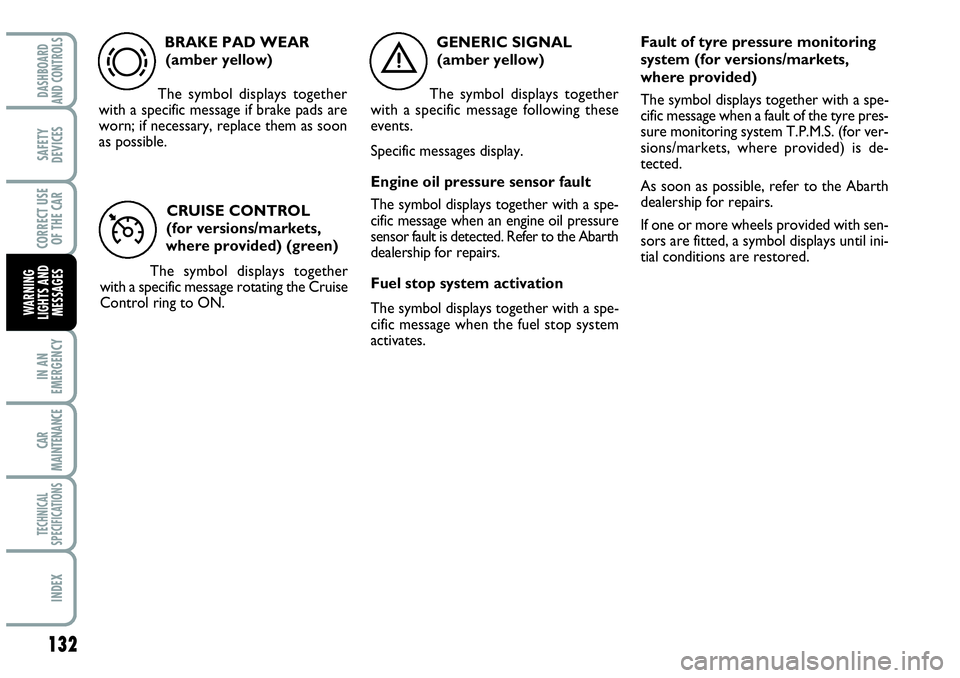
132
IN AN
EMERGENCY
CAR
MAINTENANCE
TECHNICAL
SPECIFICATIONS
INDEX
DASHBOARD
AND CONTROLS
SAFETY
DEVICES
CORRECT USE
OF THE CAR
WARNING
LIGHTS AND
MESSAGES
BRAKE PAD WEAR
(amber yellow)
The symbol displays together
with a specific message if brake pads are
worn; if necessary, replace them as soon
as possible.
d
CRUISE CONTROL
(for versions/markets,
where provided) (green)
The symbol displays together
with a specific message rotating the Cruise
Control ring to ON.
Ü
GENERIC SIGNAL
(amber yellow)
The symbol displays together
with a specific message following these
events.
Specific messages display.
Engine oil pressure sensor fault
The symbol displays together with a spe-
cific message when an engine oil pressure
sensor fault is detected. Refer to the Abarth
dealership for repairs.
Fuel stop system activation
The symbol displays together with a spe-
cific message when the fuel stop system
activates.
è
Fault of tyre pressure monitoring
system (for versions/markets,
where provided)
The symbol displays together with a spe-
cific message when a fault of the tyre pres-
sure monitoring system T.P.M.S. (for ver-
sions/markets, where provided) is de-
tected.
As soon as possible, refer to the Abarth
dealership for repairs.
If one or more wheels provided with sen-
sors are fitted, a symbol displays until ini-
tial conditions are restored.